| Home Page | New Data | Chronology | Cast Coins | Struck Coins | Paper Money | Links/Reference |
Coins That Indicated The Devaluation of The Currency
| In the long series of the Chinese coinage that has extended for more than 2000 years. Most of the coins were issued with copper, but some of them were cast with other metals, such as silver and iron or lead. I think collectors would not like the iron coins. It is because the ugly appearance of the iron coins. Actually it is difficult to obtain the iron coins in collectable condition and they are rare in comparison with those made of copper.
The use of iron coins, first appeared in Szechwan basin during the Han Dynasty, |
Extremely Rare A ~ Very Rare B ~ Rare C ~ Not So Many D ~ Common E
| Obverse | Reverse | Description |
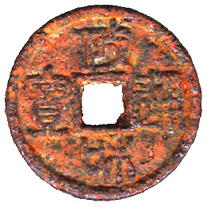 |
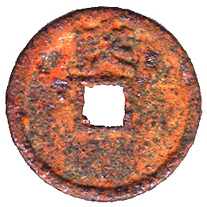
| No. 124 |
| Diam. 31 mm | ||
| Hole Diam. 8 mm | ||
| Wt. 11.0 g. | ||
| Rareness D | ||
| Mint Evolution and Peculiarity | ||
This coin was cast from 1111AD to 1118AD, during the period Cheng Ho of Emperor Hui Tsung of the Sung Dynasty. The legend on the obverse of this coin is written in seal script and the characters of the legend are read in the normal manner. Chinese character "Shen"  on the reverse showing the mint name of Shenhsi area. I think this may be the first use of a mint name by Sung Dynasty. on the reverse showing the mint name of Shenhsi area. I think this may be the first use of a mint name by Sung Dynasty. | ||
| Obverse | Reverse | Description |
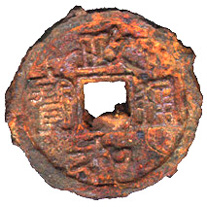 |
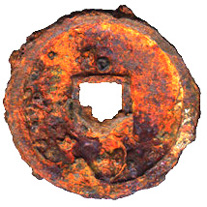
| No. 125 |
| Diam. 32 mm | ||
| Hole Diam. 8 mm | ||
| Wt. 11.2 g. | ||
| Rareness D | ||
| Mint Evolution and Peculiarity | ||
| This is another "Cheng Ho T'ung Pao" coin, but the legend is written in orthodox characters. A variety of calligraphic styles was commonly used in the legends of Sung Dynasty. The legend of this coin is read in the normal order. | ||
| Obverse | Reverse | Description |
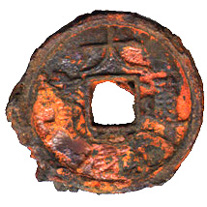 | 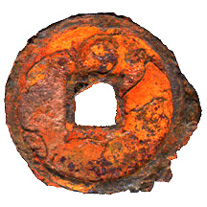 | No. 126 |
| Diam. 25 mm | ||
| Hole Diam. 8 mm | ||
| Wt. 11.6 g. | ||
| Rareness D | ||
| Mint Evolution and Peculiarity | ||
This "Ta Kuan T'ung Pao" was cast in the period of the Ta Kuan reign (1107AD-1111AD) of Emperor Hui Tsung. The inscriptions of this coin are not so clear, but the characters punched on the obverse of this coin were written by Emperor Hui Tsung. His handwriting is very famous for featuring bold, vigorous and elegant strokes. It is known as  "Shou Chin Ti" style. "Shou Chin Ti" style. | ||
- - : More about Sung cash :- -
 "Kungsun Shu", a local ruler who started casting iron coins "Wu-shu" and put them into circulation. [I find that copper was always too expensive in Szechwan area in the ancient China.]
"Kungsun Shu", a local ruler who started casting iron coins "Wu-shu" and put them into circulation. [I find that copper was always too expensive in Szechwan area in the ancient China.] ,
, (A dictionary of ancient Chinese coins), 1982.
(A dictionary of ancient Chinese coins), 1982.